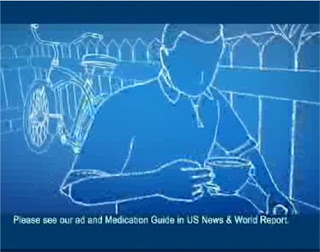 Pfizer’s new Celebrex TV ad, which aired last night for the first time during ABC’s World News with Charles Gibson, was unique in several respects. But what did viewers learn from this two and a half minute commercial? I invite you to take a little test at the end of this post.
Pfizer’s new Celebrex TV ad, which aired last night for the first time during ABC’s World News with Charles Gibson, was unique in several respects. But what did viewers learn from this two and a half minute commercial? I invite you to take a little test at the end of this post.
First, however, let’s list the ways that this commercial was different. Pfizer obviously thinks this commercial is special — it has placed the entire video clip on the Celebrex Web site home page.
Length and the Communication of Risk
This was more of an infomercial than a typical commercial. In fact, it was the ONLY commercial interruption during the half-hour of the news program. Charles Gibson made a big deal of this right at the beginning of the show and promised that will be a new feature every Monday on ABC World News. Whether or not Celebrex remains the sole sponsor on Monday is yet to be seen. But as soon as Charles said that, I knew I was watching the right news program.
Many critics of FDA regulations regarding DTC claim that 60 seconds is too short a period to balance all the required risk information with benefit information (see, for example, “DTC without the Risk“). It’s refreshing to see an approach that solves this problem by devoting more time to communicating risk. The Celebrex ad did a good job listing all the risks in 150 seconds. But the benefit statements were all geared to comparisons with other NSAIDs, especially prescription naproxen and ibuprofen, which leads to the second unique aspect of this ad.
Direct Comparison with Competitors
Very few drug ads offer comparisons with competitive products. Mostly, this is because to make such comparisons, claims must be backed up by studies and so few comparison studies have been done. In the NSAID arena, however, there are plenty of studies. The Celebrex commercial repeatedly cites studies in making its claim that Celebrex is at least no worse than other NSAIDs with respect to cardiovascular (CV) and other side effects.
We don’t hear, however, any results from an on-going Pfizer-supported trial comparing Celebrex, naproxen, and ibuprofen in patients with both heart disease and arthritis, which would “answer once and for all questions about the relative cardiovascular risks of these agents” (see “Definitive study of anti-inflammatories in heart disease?“). Time will tell.
Creative “Pencil Test” Animation
The new Celebrex ad is also different in its creative execution. Instead of using actors, it uses a unique kind of 3-D animation. It resembles a black and white “pencil test” draft that animators often use before creating the full-color, full-body animation. We don’t see any facial expressions on the animated characters in this commercial. The creative twist, however, is that the outlines are all strings of text, which the narrator reads.
So, What Did you Learn?
A lot of information was presented in this ad. At one point, when you thought the ad was over, the narrator says “Let’s dive deeper!” An advertising maxim is to present 2 or 3 main messages at most because the audience can’t absorb any more than that. How much did you take away from the ad? Did you absorb correctly all the claims made? Look at the ad again, and take the little test below. I will reveal the correct answers in a follow-up post. Thanks for your input!
| Which claims were made in the New Celebrex TV Ad? | |
| Rx naproxen and ibuprofen have CV risks.FDA requires all NSAIDs, including Celebrex, to have same CV warning.Celebrex use may lead to heart attack or stroke, even death.Celebrex, unlike naproxen or ibuprofen, does not cause stomach bleeding.Celebrex has never been taken off the market.FDA says Celebrex’s benefits outweigh the risks for most patients.Unlike other NSAIDs, Celebrex can be used with lose-dose aspirin.Risk of CV events increases when Celebrex is taken for long periods.Celebrex may cause stomach bleeding, which can lead to death.Studies show Celebrex is a better option than naproxen or ibuprofen for pain relief in elderly patients. | |
| To select multiple entries hold the Ctrl key (or the Apple key) | |









![6 Digital Tools at the Center of Healthcare Digitalization [INFOGRAPHIC]](http://ec2-54-175-84-28.compute-1.amazonaws.com/pharma-mkting.com/wp-content/uploads/2021/04/6DigitalTools_600px-100x70.jpg)




